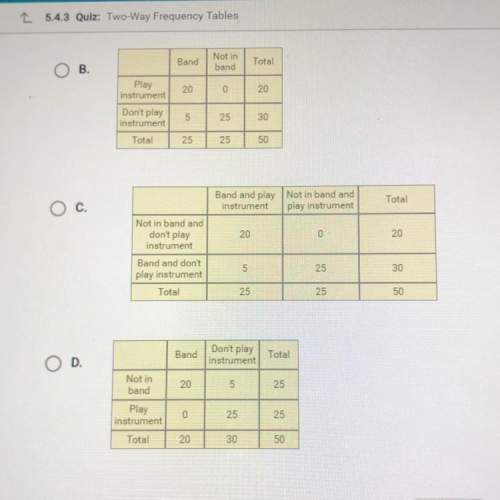
Mathematics, 17.12.2020 02:20 leshayk91
The vertices of ΔABC are A (1, 5), B (3, 9), and C (5, 3). The vertices of ΔDEF are D (−3, 3), E (−2, 5), and F (−1, 2). Which conclusion is true about the triangles?
The ratio of their corresponding sides is 1:3.
They are congruent by the definition of congruence in terms of rigid motions.
The ratio of their corresponding angles is 1:3.
They are similar by the definition of similarity in terms of a dilation.

Answers: 3


Another question on Mathematics

Mathematics, 21.06.2019 14:30
Find the value of tan theta if sin theta = 12/13 and theta is in quadrant 2
Answers: 1


Mathematics, 21.06.2019 18:30
An optical inspection system is used to distinguish among different part types. the probability of a correct classification of any part is 0.92. suppose that three parts are inspected and that the classifications are independent. let the random variable x denote the number of parts that are correctly classified. determine the probability mass function of x. round your answers to four decimal places (e.g. 98.7654). x f(x) 0 1 2 3
Answers: 2

Mathematics, 21.06.2019 19:40
What happens to the area as the sliders are adjusted? what do you think the formula for the area of a triangle is divided by 2?
Answers: 1
You know the right answer?
The vertices of ΔABC are A (1, 5), B (3, 9), and C (5, 3). The vertices of ΔDEF are D (−3, 3), E (−2...
Questions

Mathematics, 07.04.2020 00:53



Mathematics, 07.04.2020 00:53

English, 07.04.2020 00:53

Mathematics, 07.04.2020 00:53

Social Studies, 07.04.2020 00:53



Mathematics, 07.04.2020 00:54


Mathematics, 07.04.2020 00:54

Mathematics, 07.04.2020 00:54


History, 07.04.2020 00:54


Mathematics, 07.04.2020 00:54






